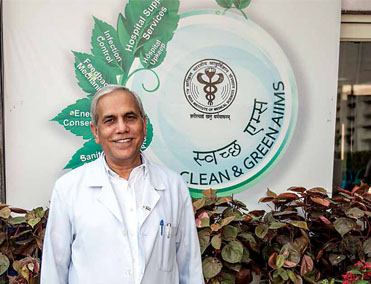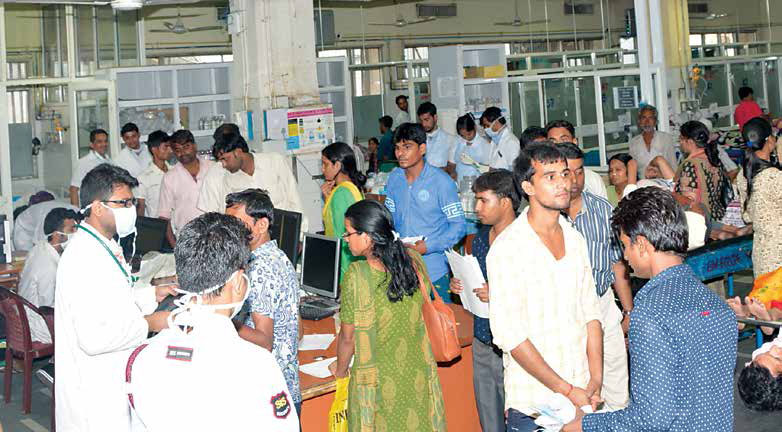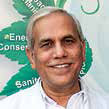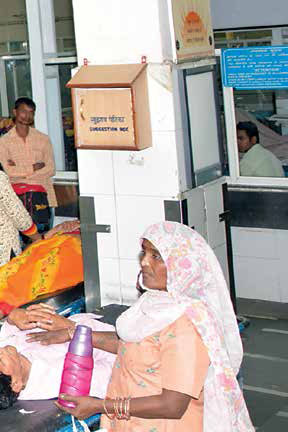Issue No.17 / November 1-15,2015

If 60,000 young lives were lost on our roads in 1988, it is 150,000 lives now. So trauma was a problem at that time and it’s a problem now. The only difference is that now it has taken epidemic proportions
In Conservation with Dr.Mahesh Chandra Mishra,Director of All India Institute of Medical Services(AIIMS) Delhi-the best branded Indian Hospital which is acknowledged world over. This centre started with just 10 departments in 1956, today has over 54 departments and centres
Achieving great heights in your career has nothing to do with where you come from. You might not be born into riches; you may not have success and fame spoon-fed to you but you can always believe in yourself and make it big in life. The story of the director of Delhi’s All India Institute of Medical Sciences, Dr Mahesh Chandra Mishra reflects clearly this simple truth of life. Born into the family of a humble teacher from Tundla (UP) with limited means and huge responsibilities, he is the perfect example of ‘your dreams can turn true if you remain positive and sincere towards your goals.’ Winner of the Dr BC Roy National Award of the Medical Council of India in 1996 for developing the speciality of minimally invasive surgery in the country, Dr Mishra is rated amongst the best surgeons and trauma care experts in the country. He has received fellowships from the American College of Surgeons (FACS), the National Academy of Medical Sciences, India (NAMS), and Royal College of Physicians and Surgeons, Glasgow, UK (FRCS-Glasgow). In a candid interview with Corporate Citizen, the eminent surgeon with over four decades of experience narrates the journey of his life - which has many important lessons for us all. Excerpts:

When you look back, you realise, 35 years is a long time as all my youth has gone here. And, if you consider it in totality, right from 1970, when I got admitted to medical school, it comes to 45 years, which is almost half a century! But it has been a very satisfying, very rewarding experience. More so, because if you wish to remain in the academic field and want to work at India’s best institution, there is nothing better than AIIMS Delhi, and I’m fortunate that I got this opportunity. I got selected as a faculty here in 1984 and then subsequently, I kept getting promotions while working on various positions as lecturer, assistant professor, associate professor, additional professor and then professor and finally director, AIIMS. In between, I had gone to the UK in 1988 to pursue a fellowship for a year in trauma care services.
I remember, many people laughed when I went on this fellowship. What is this trauma, and why are you going, were some of the questions they asked. But I knew how important it was for India. For a country where someone dies in a road accident every two minutes, India badly needed the best possible trauma services which it did not have. If 60,000 young lives were lost on our roads in 1988, it is 1,50,000 lives now. So, trauma was a problem at that time and it’s a problem now. The only difference is that now it has taken epidemic proportions. According to the WHO, after cardio-vascular diseases and mental health illnesses, the third top disease in India responsible for disability-adjusted-life-years lost is nothing but injury. So, a full-fledged trauma centre to treat victims of road accidents was very much required at AIIMS Delhi, and it finally became a reality in 2006 in the form of Jai Prakash Narayan Apex Trauma Center, New Delhi. What I learnt in the UK proved to be of great help while providing state-of-the art services at the trauma centre.
Not that we have done away with all the infections but they are on a decline, though dengue has been creating a lot of scare recently. But an infection like HIV, which was the top disease in 1999, will go down to number 10 position by 2025-30. But problems related to the elderly population are on the rise, and so is the case with lifestyle diseases like cardiovascular disorders and even cancer. Meanwhile, India has today become the diabetic capital of the world. Then there is the problem of poor physical infrastructure, both in urban and rural India.
Over the past six decades, AIIMS Delhi has become a household name in India and abroad. The number of patients has also gone up tremendously over the last three and a half decades that I have been here. In 1984, when I joined, there was only the main hospital. Now, we have many speciality centres such as Cardio- Thoracic Centre, Neurosciences Centre, Cancer Centre and many other centres. Now, we have a Trauma Centre. We started with 10 departments in 1956 but today we have almost 54 departments and centres.

The surgical centre is almost ready. Nine floors have come up. Work on the mother and child centre is in rapid progress. Excavation has begun. So is the case with the new OPD block and the new private ward. Meanwhile, the Delhi Development Authority (DDA) has given us a 15-acre plot adjacent to the trauma centre on which we will add a 2200-bed facility as part of our expansion programme for the trauma centre. So our bed capacity which, as of today is 2,500 for all departments and centres will grow to 4,700 and further 3,200 will be added once we have all those plans of the surgical centre, mother and child and elderly blocks ready, along with the new emergency block in the next seven to ten years. We will have close to 8,000 beds. Then a cancer institute is coming up at an off-site centre in Jhajjar. We have a 300 acre plot which has been given to us by the Haryana government. This will be the first-of-its-kind, a comprehensive, national cancer institute with all state-of-the art facilities
That will have a 700-bed capacity, solely for cancer patients, all types of cancers. We are also envisioning a national cardio-vascular centre at Jhajjar with plans for many other such units in the pipeline. Meanwhile, we have got tunnel connectivity ready between AIIMS and the trauma centre which has been built by the Delhi Metro Rail Construction (DMRC). We expect to open it for public use soon. Then residential accommodation facility for faculty and staff is also in the pipeline. We are also planning to redevelop the western campus and the nearby Ayur Vigyan Nagar. These are huge plans with projects worth Rs.6,000 crore getting completed soon. We will now submit a proposal for another set of projects worth about Rs. 15,000 crores to the government. All this has been done in the last two years since I took over as the director in October 2013, and it’s considered huge because we haven’t witnessed such a heavy dose of development at the AIIMS campus in the last 60 years.

We don’t give any intramural research grant. In fact, it is very small. But people attract grants from all over, especially from other funding agencies such as the Indian Council of Medical Research (ICMR), Department of Bio-technology, Department of Science & Technology, Council of Scientific & Industrial Research (CSIR), other international funding agencies like America’s National Institute of Health (NIH), the Centre for Disease Control (CDC), the Medical Research Council, to name a few. The researchers apply globally and get funding for their projects. Recently we got a $ 1.3 million grant from CDC for anti-microbial surveillance. This is what most universities should actually do to attract funds for their research projects. You cannot depend on the grant from within only, thereby putting pressure on taxpayers. You generate your own funds from institutions like the Bill Gates Foundation, and other such agencies. For example, the Bill Gates Foundation gave $400 million grant for the HIV project and that’s how we were able to conduct it. That is where global charitable organisations like the Welcome Trust and many others come handy, because they have huge funds to give. Now, recently, Infosys has come forward and gave us two chairs of five crore each, for research in cancer and gynaecology. That’s how we operate and that’s how it happens even overseas. Research has been a focus area for us. In fact, we have a trinity of three missions -- patient care, research and education, and training. Two days ago, the Dean of Research told me that Scopus, which is the largest abstract and citation database in America, has declared that we are number one among medical research institutions. So you cannot say that our performance is bad as compared to the rest of the world’s research output in the field of medicine.
Institution-building takes time. Even this AIIMS Delhi took 60-odd years to come to this level. So, how do you expect the new institutions to come up in such a short time? As it is, they are bogged down by so many difficulties of delayed construction. But this is neither under the control of the government nor in the control of directors who are heading these institutions. There are huge problems of contractors, and if they are not doing their work honestly, what can one do? We can only blacklist them. We can only punish them but it only delays the project and that has been happening with most such institutions which are coming up. Even with AIIMS Delhi, we were using the Safdarjung Hospital until our hospital building got ready. It may not take 60 years, but it may still take 30 years to come up to the level of AIIMS Delhi. And, then, attracting good faculty is a herculean task. People are just not attracted to the kind of salary our governments offer compared to what corporate hospitals offer. That is also a problem. This institution came up because when Prime Minister Nehru would go to UK or USA, he would meet talented people there and pick them up. He’d say, OK, you come down. He had credibility and many doctors came. Today, why will one join AIIMS from the Medanta Hospital in Gurgaon? Times have changed but I’m very confident that all these new AIIMS will also come up finally and they’ll serve the country as the AIIMS Delhi has been serving for all these years.
A few years ago, we were thinking that with big hospitals coming up in the corporate sector, AIIMS might lose its place in the society and the nation. But it hasn’t happened that way. On the contrary, if independent surveys are to be believed, we have remained No.1 in the country for the last 14 consecutive years!

I agree that the number of PG seats is less than half of that for undergraduates. But then there are programs like the Diplomate of National Board (DNB) from the Ministry of Health. We all would like to see more seats available at the PG level but for that you also need more faculty at medical colleges. We also need more medical colleges to come up with proper standards. Unfortunately, in medicine, you cannot produce doctors overnight. It’s not like the civil services where you start working soon after a year’s training. That’s not possible here. If four and half years of study are needed, they’re needed. It can’t be compromised. In fact, in some countries, it is six and even seven years’ study for an MBBS degree. We’re fortunate that we’re still following the practice of 4-1/2 years, thanks to the decision taken at the time of the 1965 Indo-Pak war when the country needed more doctors. The government reduced the length of MBBS course by six months, and that practice is continuing to date.
Even if you complete the construction of 16 AIIMS at jet speed, where will you find the faculty for so many institutions? We don’t have it. We’ve to generate it gradually over a period of time. That’s why institution building takes time and we have to be patient. What we need to do is to cater to primary and secondary care. Do we really need doctors everywhere? Other countries have tackled this problem by putting in nurses and paramedics. We also need to shift our focus a little bit from doctor-centric to paramediccentric at primary care. Tell me, why do we need a doctor to conduct a delivery? Aren’t female health workers ASHA (or Accredited Social Health Activists), working under the Ministry of Health, performing community deliveries successfully? Aren’t babies born in trains/ planes and even on the street? Normal deliveries are possible anywhere. You need a doctor only when there is some complication. Isn’t it?
AIIMS fortunately does not have that much attrition of faculty. It has never been more than three to five per cent a year. It is very low. But the majority of those who are trained here cannot be absorbed at AIIMS. They have to go out and that is what our job is. That is what the objective of this institution is to provide trained medical and paramedical manpower to the country.
That is their individual choice. These are individual matters. If somebody wants to go, say to the Gulf, and the salary difference is ten times, some people would obviously want to leave AIIMS. Recently one of the assistant professors who had moved here from the private sector came to me within a year or so and said, ‘Sir, I want to leave.’ I said, why? ‘Because of my financial problems,’ he said, narrating how, being the single earning member of the family who also had to marry off a sister and take care of old parents, he was finding it difficult to make both ends meet on a one lakh salary. Now that’s something we have to see -- as to how we can make AIIMS jobs financially more attractive for our young doctors. He was offered a Rs.3 lakh per month salary in the Gulf. So, what could you do in such a scenario?
It did. When we went to the UK in 1988-89, we could have stayed there. Both I and my wife were getting a job there but we always wanted to come back. I also went to the Gulf for some time but again I came back. So, there is nothing wrong if one needs a little money for mental security and there can be honest mechanisms devised for these kinds of situations too.
I don’t agree. A few years ago, we were thinking that with big hospitals coming up in the corporate sector, AIIMS might lose its place in the society and the nation. But it hasn’t happened that way. On the contrary, if independent surveys are to be believed, we have remained No.1 in the country for the last 14 consecutive years! We don’t sponsor any surveys ourselves. But recently, in an independent UK-based survey, they rated AIIMS Delhi as the best branded Indian hospital while naming one each hospital from the USA, UK, Singapore and Thailand, to name a few. So the brand AIIMS is acknowledged the world over. But it is true that corporate sector hospitals also provide excellent services. However, they are not doing any undergraduate or post graduate teaching and training of doctors, which we are doing. In fact, they are taking doctors trained by us to provide quality healthcare at a price. So, there is no comparison and I think it is not fair to compare from that perspective. Now, some people will always want to leave and look for greener pastures and why should we stop them? Our job is to create more and more trained human resources for the country and we’ve been doing that quite sincerely. AIIMS has contributed immensely to nation building over the last 60 years, and there can be no comparison in that regard.
What Dr Shetty has done, we have already been doing for the last 60 years. Who is paying for Dr Shetty’s patients? It’s the government of Karnataka or some insurance mechanism which is paying for his services. Like in Andhra, they have Arogyashree Yojana, in Tamil Nadu, they have Amma brand Arogya Thittam, and even in Delhi, they have this Rashtriya Swasthya Beema Yojana. So, such schemes are there in all the states and Dr Devi Shetty gets paid by the Karnataka sarkar for those he treats for, say, Rs.50,000 per heart surgery. But that is the cost that we also charge. So, he is not doing something that has not been done in this country. But, yes, he has shown that private hospitals also can also contribute by this mechanism. If a government subsidises, then top-quality medical care can be made available to the poor through the public-private partnership and it can be a big success story in certain areas. But whatever he is doing is not free. In fact, here at AIIMS, many a times we exempt all such charges for a BPL patient. That liberty we have, because the government gives us the money, so we do it.
As I told you, my father was a teacher who worked very hard to bring up all his children. I have five sisters. They are all happily married, four of them are in Lucknow and one is in Agra and my eldest brother is in Gurgaon, retired from the railways. My doctor brother is no more. Both my parents have also left for their heavenly abode. My wife is a gynaecologist. She was also working at AIIMS but she took voluntary retirement in 2006 and is now working in the private sector, and my two sons are working in the United States.
No. They both are engineers. One of them is an MBA and the other is into computers. They are happy with what they are doing.
Three words: Compassion, communication, trust. These are the three bottom lines of ethical medical practice. Before you treat/ advice someone, think what you would have done if he had been among your near and dear ones? If you do that, you won’t regret in medical practice.
Our bed capacity which, as of today is 2,500 for all departments and centres will grow to 4,700 and further 3200 will be added once we have all those plans of the surgical centre, mother and child and elderly blocks ready, along with the new emergency block in the next seven to ten years. We will have close to 8,000 beds.
If you’re compassionate to the patient and if you communicate properly, and if you do what is required for that patient, then trust will always be there. There is no question of mistrust. Mistrust arises because people feel that some unnecessary investigations/ operations are done and that’s why trust gets eroded.
As for Clean India or Swachh Bharat, we in the medical profession cannot ask for more. Most of our health problems are related to hygiene and cleanliness issues. It also looks good if our surroundings are clean. So nobody can disagree with such a program. Rather, we should all contribute towards making it a success. Similarly, I strongly feel that the time has come to make the Make in India a reality even in the healthcare sector.
Oh yes, we invited about 50 odd students from various Kendriya Vidyalayas and also EWS category students for our 43rd convocation on October 18th this year.
Unfortunately, in the medical field, other interests take a back seat. So, even if we have a movie ticket in our hands and a call comes from the hospital, we have to forego that. We have done that several times. But I do have some interests. I like listening to ghazals of Jagjit Singh. I love music.
Be positive. Be transparent. Don’t have malice towards anyone. Do everything that you want to do honestly and without harming anyone. I see no reason why one would not succeed if one follows these simple rules. Have a positive mindset because negative things will happen around you but you have to just ignore them.
By Pradeep Mathur